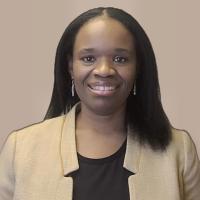Ebony Holliday, PhD, assistant director of Community Programs at Kennedy Krieger Institute’s Center for Autism Services, Science and Innovation (CASSI), talks about how schools — through an educational diagnosis or educational identification, which is different from a medical diagnosis — can be more proactive in recognizing the traits of autism and knowing the available services so as to better help students with with autism spectrum disorder (ASD).
This video appears in:
Transcript
There is a clear difference between what we would consider a medical diagnosis of autism and an educational diagnosis or an educational identification. So while there are similar features of those, sometimes the evaluations look somewhat different and the resulting language sometimes that is used is different. So in schools, it is possible to receive an educational identification of autism, and that will be following a comprehensive evaluation if that was deemed necessary by the school team. And so they would look to see if the child required special education services for progressing through the educational curriculum. So that’s really the purpose of an educational identification or a diagnosis in the school system, is to really support the education piece of things. Does that child, does that student need support in their education in order to make progress? Whereas a medical diagnosis is really looking at those clear criteria based on the DSM five and is looking to see if those symptoms are present and looking to see how that impacts their daily life and their daily functioning.
And so typically a evaluation can be requested from the school. And if, again, if the team agrees to that and sees that it’s necessary, that there hasn’t been an impact on the child’s education, that’s something that can be done. And so that can proceed without necessarily a medical diagnosis. But oftentimes what happens is if the educational identification comes first, the school team may make a referral and suggest that the family follows through with that medical diagnosis. Oftentimes, it is that medical diagnosis that is needed to get access to different services in the community, whether that is different types of interventions, different programs that might be available in the community. Sometimes that diagnosis, that official medical diagnosis is needed. It can really be difficult navigating the system to get a diagnosis and to get the appropriate services and care. And unfortunately, for some families, sometimes it’s a multi-year process.
When we think about the time that families or maybe even a provider identifies the beginning signs or has some concern to the time that they may receive a diagnosis, it can be months if not years for some families for that. So navigating that, what we call that diagnostic process, can be a challenge for families. We do know this, and so I think a lot of providers and communities are really trying to help with that. And so a lot of times there may be support at different levels. So for example, if we talk about early intervention, a lot of times those providers are trained to do what we call service as well and to see what else might be needed for that family. Do we need to refer them to this system? So sometimes providers who have that knowledge are working more with families to help them move through the system because everything is not necessarily clearly laid out.
There’s a lot to figure out. There’s a lot of information online, and sometimes it’s information overload. And so it’s difficult for families or even individuals to know where to start and not just where to start, but what information can I trust, what information is actually legitimate and accurate? And so it’s a lot to wade through. And so I think a lot of times we have, whether it’s medical clinics or whether it’s schools, we have people who may be there to support families in that journey and working through things as well. And I’ll mention educational advocates do also a nice job at this piece of partnering with families or different community organizations that are out there to support families who have children with disabilities or special healthcare needs or neurodevelopmental differences and delays. There are community organizations that are out there. So it’s a really good first step is to get connected with either other families, other providers, or a network that’s really going to help that family that might be new to that journey, really navigate those things that are necessary. We definitely find that that advocacy piece, families really learn that they have to kind of take that role of being their child’s advocate, whether it’s at school or navigating all of these different appointments. So I think that is a piece that really comes into play for families is learning how to be their child’s advocate during this process.
